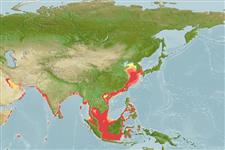Mammalia |
Cetartiodactyla |
Phocoenidae
Environment: milieu / climate zone / গভীরতার পরিসীমা / distribution range
বাস্তুসংস্থান
ভাসমান; এ্যানাড্রমাস (সূত্র 75906); গভীরতার পরিসীমা 0 - 250 m (সূত্র 356). Tropical; 90°N - 7°S, 46°E - 130°E
Indo-West Pacific and Asia Inland Waters: Neophocaena phocaenoides phocaenoides: Persian Gulf, South China Sea, East China Sea, Indonesia, Philippines, Turtle Islands, Sulu Sea; Neophocaena phocaenoides sunameri: China, Korea, Japan, East China Sea; Neophocaena phocaenoides asiaeorientalis: Yangtze River, China (Ref. 1522). Found in tropical to warm temperate coastal waters (Ref. 81021).
Length at first maturity / আকৃতি / Weight / Age
পরিপক্কতা : Lm 140.0, range 135 - 145 cm Max length : 227 cm TL পুরুষ/ লিঙ্গ অনিধর্ারিত ; (সূত্র 81030)
Found in both fresh and marine. Feeds on small fishes, squids and shrimps; also ingests some plant material including leaves and rice (Ref. 1394). In 2006, a population survey was able to record a total of 300 individuals of Neophocaena phocaenoides asiaeorientalis, as experts provide an estimate of 1,400 individuals based on the said survey. This is considered a 50% decline from the survey done in 1991 (Ref. 85336). Found in tropical to warm temperate coastal waters, i.e., shallow bays, mangrove swamps, estuaries and large rivers, but mainly prefers estuarine waters (Ref. 81021). Occurs singly, in pairs, or in small groups of up to 12 individuals. Not as showy as other dolphins; though, they are occasionally seen breaking the surface in calm seas (Ref. 801). Feeds on small fishes, squids and shrimps; also ingests some plant materials including leaves and rice (Ref. 1394).
Life cycle and mating behavior
পরিপক্কতা | প্রজনন | ডিম ছাড়া | Eggs | ডিম্বধারন ক্ষমতা | Larvae
Tan, J.M.L. 1995 A Field Guide to the Whales and Dolphins in the Philippines. Makati City: Bookmark. 125 p. (সূত্র 936)
IUCN Red List Status
(সূত্র 130435: Version 2025-1)
CITES status (সূত্র 108899)
Threat to humans
Human uses
মৎস্য: বাণিজ্যিক
FAO - মৎস্য: landings, species profile | FishSource | আমাদের চতুর্পাশ্বের সাগর
হাতিয়ার
আরো তথ্য
Physiologyঅম্লজান ব্যবহার
Human RelatedStamps, coins, misc.
ইন্টারনেট সুত্র
Estimates based on models
Preferred temperature
(Ref.
115969): 24.4 - 29.2, mean 28.3 (based on 1892 cells).
স্থিতিস্থাপক
উচ্চ, সর্বনিম্ন প্রজন দ্বিগুনের সময় ১৫ মাস (K=0.71-0.74; tm=5).
Fishing Vulnerability
High vulnerability (57 of 100).
Price category
Unknown.
